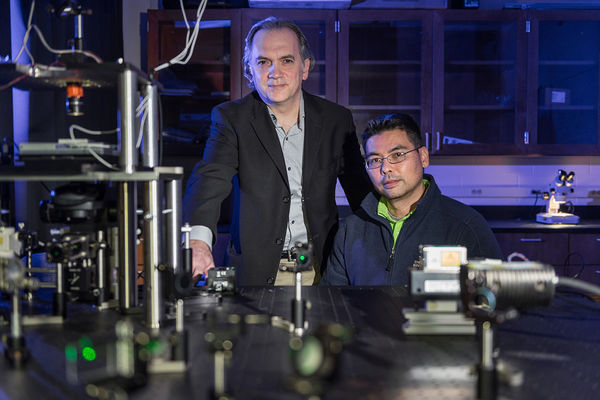
Researchers in the theoretical condensed matter physics group of Professor Boldizsár Jankó and collaborators have solved a decades-old mystery of fluorescence intermittency – blinking – that indicates classical physics behavior in a quantum mechanical system. The breakthrough explains the relatively long-lasting flashes in an experimental video by Chemistry and Biochemistry Professor Masaru Kuno of the reduction of graphene oxide. Using a random-sample Monte Carlo simulation, graduate student Anthony Ruth demonstrated that the emissions result from a chemical reaction, meaning that the video may also be the first direct movie of a chemical reaction in process. The ability to understand and control or prevent the blinking has implications in fields from flat-screen TVs to medical imaging and treatments. A paper on the discovery, “Fluorescence Intermittency Originates from Reclustering in Two Dimensional Organic Semiconductors,” was published in Nature Communications. Authors, in addition to Ruth, Jankó, and Kuno, are Michitoshi Hayashi of National Taiwan University, Peter Zapol of Argonne National Laboratory, Jixin Si of Notre Dame Physics, Matthew P.McDonald of the Max Planck Institute for the Science of Light, and Yurii V. Morozov of Notre Dame Chemistry and Biochemistry.
Research that led to the discovery started about 10 years ago when Kuno came to Notre Dame with the images of single quantum dots, taken with a single molecule microscope, that showed blinking on a timescale of seconds or even minutes that is not easily explained by quantum mechanics. More recently, Kuno saw the same blinking in a video of two-dimensional graphene reduction by lasers. The image, which resembles a sheet of paper burning at various spots that leaves differently-shaped clusters of material, makes the two-dimensional material look like a collection of quantum dots, as Jankó and Kuno described in an earlier paper.
Ruth and a collaborator in Japan discovered that a certain size range of carbon patches emitted the light that could be captured by the single-molecule spectroscope. Ruth then created a Monte Carlo simulation of chemical processes that matched the experimental video’s brightening and fading, including fluctuations in the emission trajectory. Although the emission is governed by quantum mechanics, the long-lasting fluctuation behaves more like a classical variable. The discovery provides a model in studying other fluorescent materials that could help bridge the gap between classical physics and quantum mechanics.
Originally published by at science.nd.edu on February 22, 2017.